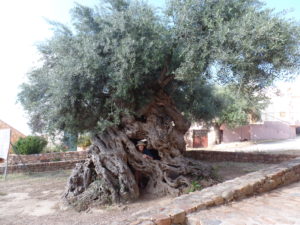
Please note that this Olive Oil Basics Blog is part 1 of a 3-part series.
An Historical Olive Tree in Greece
Olive trees, olives, and olive oil are a super important part of the culture and life in Greece. When I visited Greece, I learned fun facts about olives every day. When I visited the Greek Island of Crete, I began appreciating the olives’ significance more than I ever had before. Imagine a tree, like the one in this picture, that is more than 3,000 years old. Can you? It was mind-blowing to me when I saw the tree and realized its history – including a branch that was cut, traveled with the torch, and represented the modern 2004 Olympic Games in Athens, Greece. The enduring symbol of world peace, a native olive branch, was fitting as the world gathered in sport in the city where the modern Olympic Games began in 1896.
Modern Day Olive Trees in Greece
When I visited Crete, Greece, I was surprised to learn how important olive trees are today – not only for the economy, but also for the deeply-rooted culture of the Greek people. At a small brewery one day, a 20-something year old server seriously and sincerely explained, “the olives are who we are.” Another time, I asked an innkeeper what hobbies she enjoyed in the off-tourist season from November through March? Her answer, giggling, was “the olives!” One of my most memorable days in Crete was visiting an Organic Olive Oil Estate called Biolea which began 5 generations ago and is going strong today. The knowledge, dedication, and pride of the owners was crystal clear as they told about their olive trees and a unique system of modern-yet-traditional olive oil production they use. When I tasted their extra virgin olive oil products, I tasted the delicious heart and soul of Biolea.
Olive Trees Through the Seasons
So, how do olive trees grow? Like every living tree, the olive tree thrives in an area with the most suitable soil, temperature, rainy/dry seasons, and care of planting, pruning, and harvesting. With different seasons of the year, olive trees move through their natural cycle of life and growth. The 4 seasons of the year go like this:
- Winter – The trees basically go to sleep in the winter. Their leaves have fallen and their buds are waiting for spring.
- Spring – The trees wake up and form buds as the days get longer and and it gets warmer. There are 2 kinds of buds on the trees: flower buds that become the olive fruit; and vegetative buds that become shoots with leaves and eventually grow into new branches.
- Summer – The trees put their energy into fruit production and ripening.
- Fall – The tree’s fruit – olives – are harvested, the leaves dry out and then fall.
Olive Trees Around the World
Olive trees grow widely across countries of the Mediterranean Basin of the world, including Greece, Italy, Spain, Portugal, Turkey and North Africa, to name a few. In other parts of the world, Australia and New Zealand are involved in growing olive trees as is California in the USA.
Olive Oil is at the Center of Mediterranean Nutrition
A central food of the Mediterranean style kitchen is extra virgin olive oil. To learn more about eating nutritiously in the Mediterranean Style day-by-day, grab your free Mediterranean Menus report!
Have you seen an olive tree and, if yes, where did you see it?